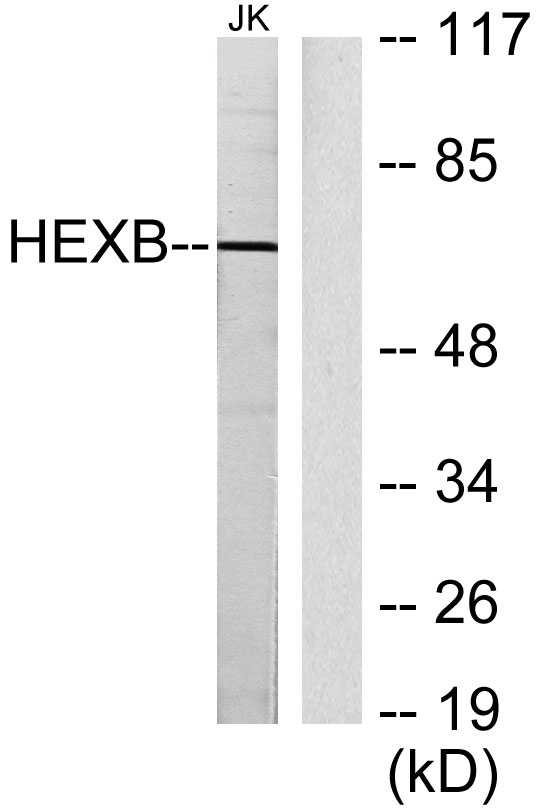Hexb Polyclonal Antibody
- Catalog No.:YT2128
- Applications:WB;IHC;IF;ELISA
- Reactivity:Human;Rat;Mouse;
- Target:
- Hexb
- Fields:
- >>Other glycan degradation;>>Various types of N-glycan biosynthesis;>>Amino sugar and nucleotide sugar metabolism;>>Glycosaminoglycan degradation;>>Sphingolipid metabolism;>>Glycosphingolipid biosynthesis - globo and isoglobo series;>>Glycosphingolipid biosynthesis - ganglio series;>>Metabolic pathways;>>Lysosome
- Gene Name:
- HEXB
- Protein Name:
- Beta-hexosaminidase subunit beta
- Human Gene Id:
- 3074
- Human Swiss Prot No:
- P07686
- Mouse Swiss Prot No:
- P20060
- Immunogen:
- The antiserum was produced against synthesized peptide derived from human HEXB. AA range:481-530
- Specificity:
- Hexb Polyclonal Antibody detects endogenous levels of Hexb protein.
- Formulation:
- Liquid in PBS containing 50% glycerol, 0.5% BSA and 0.02% sodium azide.
- Source:
- Polyclonal, Rabbit,IgG
- Dilution:
- WB 1:500 - 1:2000. IHC 1:100 - 1:300. IF 1:200 - 1:1000. ELISA: 1:20000. Not yet tested in other applications.
- Purification:
- The antibody was affinity-purified from rabbit antiserum by affinity-chromatography using epitope-specific immunogen.
- Concentration:
- 1 mg/ml
- Storage Stability:
- -15°C to -25°C/1 year(Do not lower than -25°C)
- Other Name:
- HEXB;HCC7;Beta-hexosaminidase subunit beta;Beta-N-acetylhexosaminidase subunit beta;Hexosaminidase subunit B;Cervical cancer proto-oncogene 7 protein;HCC-7;N-acetyl-beta-glucosaminidase subunit beta
- Observed Band(KD):
- 63kD
- Background:
- Hexosaminidase B is the beta subunit of the lysosomal enzyme beta-hexosaminidase that, together with the cofactor GM2 activator protein, catalyzes the degradation of the ganglioside GM2, and other molecules containing terminal N-acetyl hexosamines. Beta-hexosaminidase is composed of two subunits, alpha and beta, which are encoded by separate genes. Both beta-hexosaminidase alpha and beta subunits are members of family 20 of glycosyl hydrolases. Mutations in the alpha or beta subunit genes lead to an accumulation of GM2 ganglioside in neurons and neurodegenerative disorders termed the GM2 gangliosidoses. Beta subunit gene mutations lead to Sandhoff disease (GM2-gangliosidosis type II). Alternatively spliced transcript variants encoding different isoforms have been found for this gene. [provided by RefSeq, May 2014],
- Function:
- catalytic activity:Hydrolysis of terminal non-reducing N-acetyl-D-hexosamine residues in N-acetyl-beta-D-hexosaminides.,disease:Defects in HEXB are the cause of GM2-gangliosidosis type 2 (GM2G2) [MIM:268800]; also known as Sandhoff disease. GM2-gangliosidosis is an autosomal recessive lysosomal storage disease marked by the accumulation of GM2 gangliosides in the neuronal cells. GM2G2 is clinically indistinguishable from GM2-gangliosidosis type 1, presenting startle reactions, early blindness, progressive motor and mental deterioration, macrocephaly and cherry-red spots on the macula.,function:Responsible for the degradation of GM2 gangliosides, and a variety of other molecules containing terminal N-acetyl hexosamines, in the brain and other tissues.,online information:HEXB mutation database,PTM:N-linked glycans at Asn-142 and Asn-190 consist of Man(3)-GlcNAc(2) and Man(5 to 7)-GlcNAc(2)
- Subcellular Location:
- Lysosome . Cytoplasmic vesicle, secretory vesicle, Cortical granule .
- Expression:
- Liver,Skin,
- June 19-2018
- WESTERN IMMUNOBLOTTING PROTOCOL
- June 19-2018
- IMMUNOHISTOCHEMISTRY-PARAFFIN PROTOCOL
- June 19-2018
- IMMUNOFLUORESCENCE PROTOCOL
- September 08-2020
- FLOW-CYTOMEYRT-PROTOCOL
- May 20-2022
- Cell-Based ELISA│解您多样本WB检测之困扰
- July 13-2018
- CELL-BASED-ELISA-PROTOCOL-FOR-ACETYL-PROTEIN
- July 13-2018
- CELL-BASED-ELISA-PROTOCOL-FOR-PHOSPHO-PROTEIN
- July 13-2018
- Antibody-FAQs
- Products Images

- Immunohistochemistry analysis of paraffin-embedded human colon carcinoma tissue, using HEXB Antibody. The picture on the right is blocked with the synthesized peptide.

- Western blot analysis of lysates from Jurkat cells, using HEXB Antibody. The lane on the right is blocked with the synthesized peptide.



